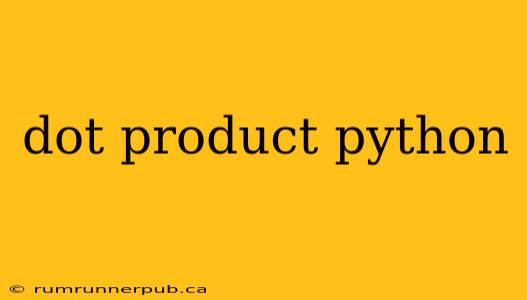The dot product, also known as the scalar product or inner product, is a fundamental operation in linear algebra with wide-ranging applications in computer science, machine learning, and physics. This article explores the dot product in Python, leveraging insights from Stack Overflow to provide a comprehensive understanding.
What is the Dot Product?
The dot product of two vectors is a single scalar value calculated by multiplying corresponding elements and summing the results. For two vectors, u = [u₁, u₂, ..., uₙ] and v = [v₁, v₂, ..., vₙ], the dot product is:
u • v = u₁v₁ + u₂v₂ + ... + uₙvₙ
Key Properties:
- Commutative: u • v = v • u
- Distributive: u • (v + w) = u • v + u • w
- Scalar Multiplication: (cu) • v = c(u • v) where 'c' is a scalar.
Calculating the Dot Product in Python: Leveraging NumPy
While you can calculate the dot product manually using loops, the NumPy library provides highly optimized functions for efficient computation. This is crucial for large datasets, where manual calculations would be significantly slower.
Example 1: Using NumPy's dot() function
This is the most straightforward method. Stack Overflow frequently features this approach.
import numpy as np
u = np.array([1, 2, 3])
v = np.array([4, 5, 6])
dot_product = np.dot(u, v)
print(f"The dot product of u and v is: {dot_product}") # Output: 32
Example 2: Using NumPy's @ operator (Python 3.5+)
Python 3.5 introduced the @ operator as a more concise way to perform matrix multiplication, including dot products.
import numpy as np
u = np.array([1, 2, 3])
v = np.array([4, 5, 6])
dot_product = u @ v
print(f"The dot product of u and v is: {dot_product}") # Output: 32
Example 3: Handling List Inputs (Addressing a common Stack Overflow question)
Sometimes, you might have vectors represented as Python lists. NumPy can easily handle this.
import numpy as np
u_list = [1, 2, 3]
v_list = [4, 5, 6]
u = np.array(u_list)
v = np.array(v_list)
dot_product = np.dot(u, v)
print(f"The dot product of u and v is: {dot_product}") # Output: 32
Beyond Basic Calculation: Applications and Interpretations
The dot product has several significant interpretations and applications:
-
Cosine Similarity: The dot product plays a crucial role in calculating cosine similarity, a measure of how similar two vectors are. This is frequently used in information retrieval and natural language processing. The cosine similarity is given by:
cos(θ) = (u • v) / (||u|| ||v||), where ||u|| and ||v|| are the magnitudes (Euclidean norms) of the vectors. A cosine similarity of 1 indicates perfect similarity, while -1 indicates perfect dissimilarity. -
Projection: The dot product helps determine the projection of one vector onto another. The projection of vector u onto vector v is given by:
proj_v(u) = ((u • v) / (v • v)) * v. -
Work in Physics: In physics, the dot product represents the work done by a force F over a displacement d. The work is given by: W = F • d.
Conclusion
The dot product is a fundamental concept with numerous applications. This article, informed by common questions on Stack Overflow, demonstrates how to efficiently calculate it in Python using NumPy, along with a deeper exploration of its meaning and practical uses. Remember to leverage NumPy's optimized functions for efficient computation, especially when dealing with large-scale datasets.
